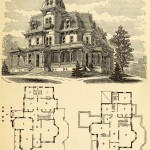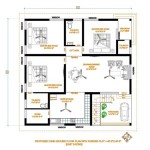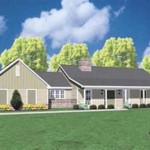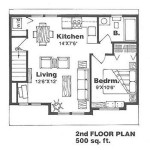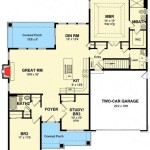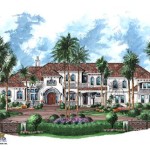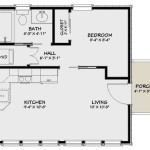3-Story House Plans with Roof Deck: Maximizing Space and Views
Three-story house plans offer a compelling solution for homeowners seeking to maximize living space on a smaller footprint. By building vertically, these designs provide ample room for families while potentially reducing land acquisition costs and preserving valuable yard space. Integrating a roof deck further enhances the appeal, creating an outdoor oasis with panoramic views and a unique entertaining area. This article explores the key considerations, design elements, and potential benefits of 3-story house plans incorporating a roof deck.
The appeal of a 3-story house plan with a roof deck lies in its efficient use of space and the added value of outdoor living. In densely populated areas or locations with strict building codes, building upwards becomes a practical necessity. A roof deck transforms otherwise unused rooftop space into a valuable extension of the home, offering opportunities for relaxation, socializing, and enjoying the surrounding environment. This combination is particularly attractive for urban settings and coastal properties where views are highly prized.
Optimizing the Design for a 3-Story Structure
Designing a functional and aesthetically pleasing 3-story house requires careful planning and attention to detail. Structural integrity is paramount, necessitating the involvement of qualified architects and engineers to ensure the building's stability and adherence to local building codes. The placement of staircases is crucial, as they will serve as the primary vertical circulation route throughout the house. Efficient staircase design minimizes wasted space and maximizes usable square footage on each floor.
The layout of each floor must be carefully considered to accommodate the needs of the occupants. Typically, the ground floor houses the main living areas, such as the living room, dining room, and kitchen. The upper floors are reserved for bedrooms, bathrooms, and perhaps a home office or study. The roof deck, while potentially accessible from the third floor, may also require a dedicated staircase or elevator depending on the design and local regulations.
Natural light penetration is another crucial consideration in 3-story house design. Large windows and strategically placed skylights can help maximize the amount of sunlight entering the building, creating a brighter and more inviting interior. Proper insulation is essential to maintain comfortable temperatures and reduce energy consumption. Energy-efficient windows and doors, along with a well-insulated roof and walls, can significantly lower heating and cooling costs.
The architectural style of the house should complement the surrounding environment and reflect the homeowner's personal preferences. Popular styles for 3-story houses include modern, contemporary, traditional, and coastal designs. The exterior materials used should be durable, weather-resistant, and aesthetically pleasing. Common choices include brick, stucco, siding, and stone. The roof design should also be carefully considered, as it will directly impact the appearance of the house and the functionality of the roof deck.
Ensuring Roof Deck Safety and Accessibility
Safety is a primary concern when designing a roof deck. Railings and barriers must be installed to prevent falls and ensure the safety of occupants. The height and design of these barriers must comply with local building codes. The surface of the roof deck should be slip-resistant, especially in wet conditions. Proper drainage is also essential to prevent water damage and maintain the integrity of the structure.
Accessibility to the roof deck is another key consideration. A dedicated staircase leading from the third floor is the most common solution. However, depending on the design and budget, an elevator may be considered, particularly for homeowners with mobility issues. The staircase or elevator should be conveniently located and easily accessible from the main living areas. The doorway leading onto the roof deck should be wide enough to accommodate furniture and equipment.
The roof deck itself should be designed to withstand the elements. Durable materials such as composite decking, treated lumber, or concrete pavers should be used. Shade structures, such as pergolas or awnings, can provide protection from the sun and rain. Outdoor lighting is essential for evening use. Consider installing weatherproof electrical outlets for powering lighting, appliances, and entertainment systems.
Considerations should also be given to noise mitigation. Roof decks can sometimes generate noise that can affect neighbors. Using sound-absorbing materials and strategically positioning furniture and landscaping can help minimize noise pollution. It is important to be mindful of noise levels, especially during evening hours.
Maximizing the Functionality of a Roof Deck
A roof deck can serve a variety of purposes, depending on the homeowner's lifestyle and preferences. It can be a relaxing outdoor living space, a private retreat, an entertaining area, or even a small garden. The design of the roof deck should reflect its intended use. For example, if the roof deck is intended for entertaining, consider incorporating a built-in barbecue grill, an outdoor kitchen, and ample seating. If it is intended as a relaxing retreat, consider adding comfortable lounge chairs, potted plants, and a water feature.
Planting greenery on a roof deck can transform it into a lush and inviting oasis. Consider using potted plants, raised garden beds, or even a vertical garden to add color and texture to the space. Choose plants that are well-suited to the climate and the amount of sunlight the roof deck receives. Irrigation systems can help automate watering and ensure that the plants thrive. Be mindful of the weight of the planters and soil, ensuring the roof structure can safely support the added load.
Furniture selection is critical for maximizing the functionality of a roof deck. Choose durable, weather-resistant furniture that complements the overall design of the house. Consider incorporating comfortable seating, tables, and storage solutions. Modular furniture can be easily rearranged to accommodate different needs. Outdoor rugs can add warmth and personality to the space.
Lighting plays a crucial role in creating the desired ambiance on a roof deck. Consider using a combination of ambient lighting, task lighting, and accent lighting to create a warm and inviting atmosphere. String lights, lanterns, and spotlights can be used to highlight architectural features and create visual interest. Motion-sensor lights can provide added security and convenience.
Integrating technology can enhance the functionality of a roof deck. Consider installing an outdoor sound system, a weatherproof television, or even a smart home automation system. These technologies can provide entertainment, convenience, and added security. Ensure that all electrical components are properly grounded and protected from the elements.
Ultimately, the design and functionality of a roof deck should be tailored to the homeowner's specific needs and preferences. By carefully considering the intended use of the space, the available resources, and the local building codes, it is possible to create a truly unique and enjoyable outdoor living area.
Exploring the Benefits of a 3-Story House with Roof Deck
The benefits of opting for a 3-story house plan with a roof deck extend beyond maximizing space. The elevated vantage point provides unparalleled views, enhancing the overall living experience. In urban environments, a roof deck offers a private escape from the hustle and bustle of city life. In coastal areas, it provides a front-row seat to stunning sunsets and ocean vistas.
The added outdoor living space increases the property value, making it a sound investment. A well-designed roof deck can be a major selling point for potential buyers. It expands the usable living area and provides a unique amenity that is highly desirable.
A 3-story house with a roof deck can also be more energy-efficient than a sprawling single-story home. By building vertically, the exposed surface area is reduced, which can minimize heat loss in the winter and heat gain in the summer. Proper insulation and energy-efficient windows can further enhance energy efficiency.
The design process for a 3-story house with a roof deck can also be more sustainable than that of a larger, conventional home. By utilizing vertical space efficiently, the footprint of the building is minimized, reducing the impact on the environment. Sustainable building materials and practices can further enhance the environmental friendliness of the project.
While the initial cost of building a 3-story house may be higher than that of a single-story home, the long-term benefits can outweigh the initial investment. The increased property value, energy savings, and enhanced living experience can make it a worthwhile choice for homeowners seeking to maximize their investment and their quality of life.

3 Story Contemporary Home Plan With Expansive Rooftop Deck 666087raf Architectural Designs House Plans

House Plan Designer And Builder 3 Y Design Cool Designs Farmhouse Style Plans

Deviantart More Like 2024 3 Y House W Roof Deck By Rjdalmacio Design Story

Stunning Three Bedroom Two Y House With A Roof Deck Ulric Home

House Plan Designs 3 Y W Roofdeck

Arabella Three Bedroom Modern Two Y With Roof Deck Mhd 2024039 Pinoy Eplans House Plans 2 Design

Three Bedroom Double Y With Roof Deck House And Decors

19 3 Y Houses Ideas House 2 Design

Arabella Three Bedroom Modern Two Y With Roof Deck Mhd 2024039 Pinoy Eplans

House Plans With Roof Deck Terraces Blog Eplans Com

